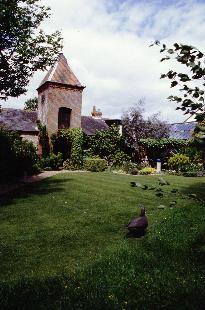 We got an early start the morning we visited Denmans, a modest perennial
garden located not far from our hotel in Chichester. Such is fate that we
would have over
three hours to visit a couple of acres at Denmans, yet
yesterday we had a mere 45
minutes to see all 250 acres at the glorious Exbury Gardens.
In fact, by the time we left the place it seemed as though we had seen every leaf,
blossom, and blade of grass several times over. Returning once again to inspect
a large stone area designed to look like a stream bed, I started snickering
about apropopriate banalities, such as "no stone unturned", and
"rolling stones gather no moss", and so on. No, we were not rushed at Denmans.
We got an early start the morning we visited Denmans, a modest perennial
garden located not far from our hotel in Chichester. Such is fate that we
would have over
three hours to visit a couple of acres at Denmans, yet
yesterday we had a mere 45
minutes to see all 250 acres at the glorious Exbury Gardens.
In fact, by the time we left the place it seemed as though we had seen every leaf,
blossom, and blade of grass several times over. Returning once again to inspect
a large stone area designed to look like a stream bed, I started snickering
about apropopriate banalities, such as "no stone unturned", and
"rolling stones gather no moss", and so on. No, we were not rushed at Denmans.
The original estate was owned by Lord Denman in the 19th century, and
by 1980 came under the care of John Brookes, a practicing
landscape designer. Formerly of the Kew School of Landscape Design at the
Royal Botanical Gardens, Mr. Brooks has founded the Clock House School
of Design at Denmans, so named for the Clock House pictured here to
the right.
Major landscape features at Denmans include a walled garden containing shrubs,
perennials, and herbs, the gravel stream bed in the center of the main garden,
a small pond and wild garden, and perennial border. Perennials seemed to
be carefully positioned to give a natural look in a semi-formal setting.
I particularly admired the grey foliage of great
mullien plants contrasting with the stone areas.
We had plenty of time to
explore the plant sales area, too. I noted a number of very choice
items and even found a variegated form of our native Tulip Poplar,
Liriodendron tulipifera.
I guess I have been
amused by how enamored the Brittish are with our native yellow poplar, one of
the most common trees in Northern Virginia.
During our two week tour, we saw a number of highly prized forms of the tree.
At home, Tulip Poplar seedlings are obnoxious weeds, coming up everywhere
and in a few short years growing to towering heights.
Poplars are very messy trees, too, since they are favored by
aphids which exude a sticky sap that sticks on leaves of other plants
and objects below. By July, this sap turns everything under the tree
to a disgusting moldy black.
The orange and green flower parts of the poplar litter
the lawn for a full month, and the profuse seeds clog the gutters later in the season.
In addition, the brittle wood of the poplar is always the first to break
in a thunderstorm, usually managing to drop its branches through
the greenhouse glass. I guess if the tree were scarce and difficult to
grow, we'd overlook its faults.
|